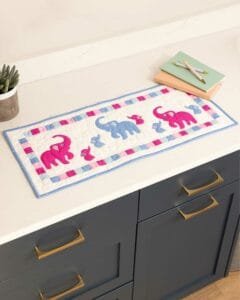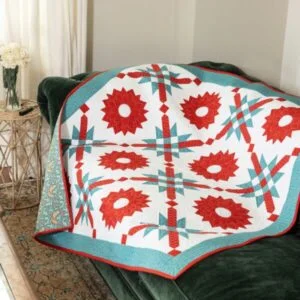Creating a Dogwood quilt is an exciting project that brings a beautiful, traditional pattern to life. In this Dogwood quilt tutorial, I will walk you through the process, step by step, making it easy for both beginners and seasoned quilters.
Whether you’re looking to craft a stunning wall piece or a cozy bedspread, this tutorial will help you achieve a flawless Dogwood quilt. With just a few supplies and a bit of patience, you’ll be well on your way to making a quilt that you’ll cherish for years to come.
The Dogwood quilt pattern is inspired by the elegant shape of the dogwood flower, with its rounded petals and central cross. This design is both classic and versatile, offering various ways to personalize the colors and layout.

Throughout this tutorial, we will cover the essential steps, from cutting your fabric to stitching the blocks together, ensuring that your quilt is both beautiful and functional.
Before diving into the process, it’s important to gather all the necessary materials. You’ll need a selection of quilting cottons in complementary colors, batting, backing fabric, thread, and your basic quilting tools like rotary cutters, rulers, and sewing machines. Once you have everything on hand, we can begin crafting your own Dogwood quilt masterpiece.
1. Preparing Your Fabric and Supplies
The first step in creating your Dogwood quilt is gathering and preparing your fabric. Here’s how to get started:
- Choosing Fabrics: For a Dogwood quilt, it’s essential to select fabrics that complement each other. You’ll want a range of light and dark tones to make the dogwood pattern stand out. Consider using pastels for a soft, floral look or bright colors for a modern twist.
- Cutting the Fabric: After selecting your fabrics, cut them into squares or triangles, depending on the specific design you’re aiming for. Use a rotary cutter and a cutting mat to ensure precise cuts, which are crucial for clean seams in your Dogwood quilt.
- Preparing the Batting and Backing: The batting provides the quilt with its warmth and loft, while the backing fabric finishes the quilt’s underside. Make sure both are slightly larger than your quilt top to allow for any shifting during the quilting process.
- Organizing Your Pieces: Once you’ve cut all the necessary pieces, lay them out to visualize the final design. This helps ensure that all colors are well balanced, and it’s a good opportunity to make any last-minute changes before sewing begins.
- Prewashing the Fabric: Prewashing your fabric before cutting and sewing can prevent any shrinking or color bleeding in the final product. This step is especially important if you’re using bold or dark colors in your Dogwood quilt.
- Marking Seam Allowances: Precision is key when piecing a quilt together. Marking your seam allowances (usually ¼ inch) on the fabric will make it easier to sew consistent, straight seams.
2. Assembling the Quilt Top
Now that your fabric is prepared, it’s time to assemble the Dogwood quilt top.
- Creating the Blocks: The Dogwood quilt consists of multiple blocks, each representing the petals of a dogwood flower. Begin by sewing together small squares or triangles to form each petal. Make sure to press the seams as you go for a crisp finish.
- Piecing the Blocks Together: After creating individual blocks, you’ll join them to form rows. Be mindful of how the seams align between blocks to ensure the quilt has a smooth, unified look.
- Adding a Border: Many Dogwood quilt designs incorporate a border to frame the central pattern. You can opt for a plain border or piece together smaller blocks to add visual interest.
- Pressing the Seams: As you assemble the quilt top, continue pressing your seams with an iron. Pressing the seams open or to one side helps reduce bulk and ensures the quilt lies flat.
- Trimming the Edges: After assembling the quilt top, trim the edges to ensure they are even. This step is crucial for preparing the quilt for the final assembly with the batting and backing.
- Checking for Consistency: Lay out your quilt top one final time to ensure all blocks and seams are consistent. Now is the time to make any adjustments if needed before moving on to the next stage.
3. Quilting the Layers Together
Once the quilt top is complete, it’s time to quilt the layers together.
- Creating a Quilt Sandwich: Lay out the quilt backing fabric, then place the batting on top, followed by the quilt top. This “quilt sandwich” will be secured before quilting.
- Basting the Layers: Basting holds the layers together temporarily as you quilt. You can use basting spray, safety pins, or long basting stitches, depending on your preference.
- Choosing a Quilting Pattern: The Dogwood quilt can be quilted using straight lines or free-motion quilting. A simple crosshatch pattern will emphasize the floral design, while more intricate stitching can add texture.
- Starting the Quilting Process: Begin quilting from the center and work your way outward. This method prevents fabric from bunching or shifting during the quilting process.
- Using a Walking Foot: If you’re quilting straight lines, using a walking foot on your sewing machine will help feed the layers evenly, preventing puckering or stretching.
- Stitching the Edges: As you approach the edges, make sure your quilting stitches remain consistent. This will ensure the quilt is sturdy and durable.
4. Finishing Touches and Binding the Quilt
Now that the quilting is complete, the final steps involve binding and finishing the Dogwood quilt.
- Trimming Excess Batting and Backing: After quilting, trim the excess batting and backing fabric to match the edges of the quilt top.
- Preparing the Binding: Cut strips of fabric for the quilt binding. These strips will wrap around the raw edges of the quilt, providing a clean and finished look.
- Attaching the Binding: Sew the binding strips to the edges of the quilt. You can do this by hand or with a sewing machine, depending on your skill level and preference.
- Mitering the Corners: To give your Dogwood quilt neat, professional corners, use the mitering technique, which involves folding the binding at a 45-degree angle at each corner.
- Stitching the Binding: Once the binding is attached, fold it over the quilt’s edges and stitch it down. You can use a slip stitch for an invisible finish or machine stitch for added durability.
- Final Press and Inspection: Give your quilt one final press to remove any wrinkles. Inspect the seams, quilting, and binding to ensure everything is securely in place.
FAQ
1. What fabrics are best for a Dogwood quilt?
Cotton fabrics are ideal for a Dogwood quilt because they are easy to work with and hold up well over time. You can also use linen blends for added texture.
2. How much fabric do I need for a Dogwood quilt?
The amount of fabric depends on the size of the quilt you’re making. Typically, for a lap-sized quilt, you’ll need about 3 yards for the quilt top and 2.5 yards for the backing.
3. What size should the quilt blocks be?
The size of your quilt blocks can vary depending on your design. Common sizes for Dogwood quilt blocks are 12 inches by 12 inches, but you can scale up or down as needed.
4. Can I quilt by hand?
Yes! Hand quilting can give your Dogwood quilt a beautiful, traditional look. It’s a slower process but adds a personal touch to your work.
5. Do I need a quilting machine to finish my quilt?
You don’t need a specific quilting machine, but a regular sewing machine with a walking foot attachment will make the process easier and more efficient.
6. How do I care for my Dogwood quilt after it’s finished?
Wash your Dogwood quilt in cold water on a gentle cycle, and air dry or tumble dry on low. This will help preserve the fabric and stitching.
Join our VIP broadcast list and gain access to exclusive patterns, all for free. As a VIP member, you’ll receive the best patterns daily, delivered directly to your device. ✨📱 It’s a unique opportunity to stay up-to-date with the latest trends and designs, curated just for you. Don’t miss out on enhancing your projects and discovering new inspirations with the best patterns every day! 🎨🔝
Conclusion
By following this Dogwood quilt tutorial, you’ve learned how to create a beautiful, timeless quilt from start to finish. Whether you’re a beginner or an experienced quilter, this project offers a rewarding experience.
Don’t forget to share your thoughts and suggestions in the comments below—your feedback is always appreciated!



